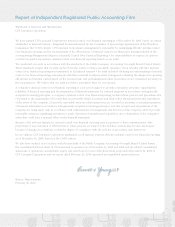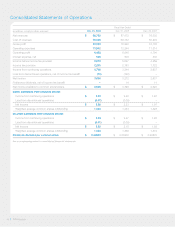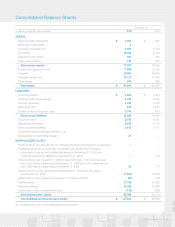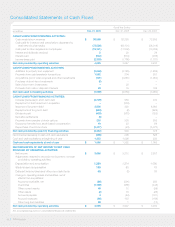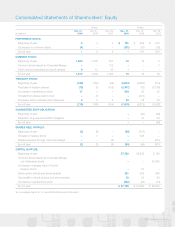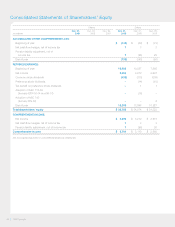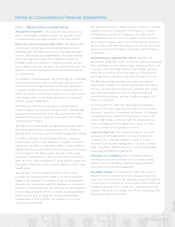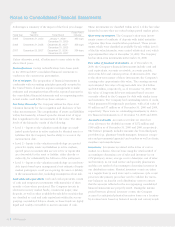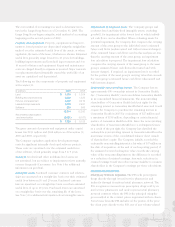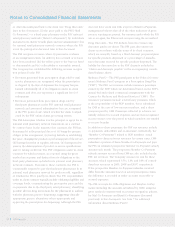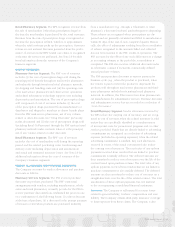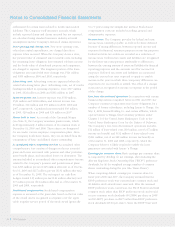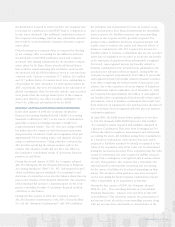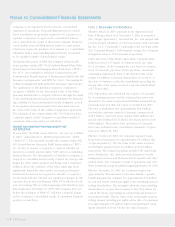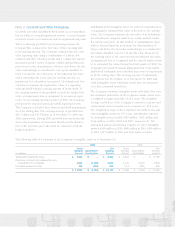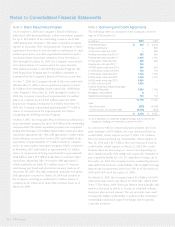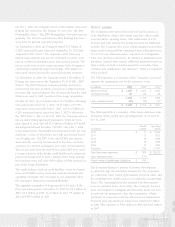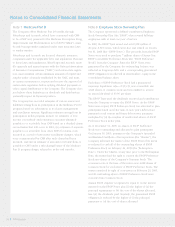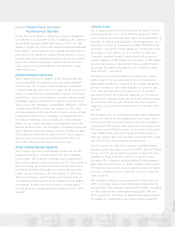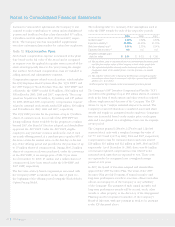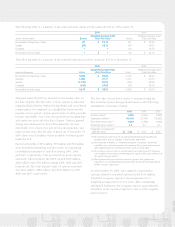CVS 2009 Annual Report Download - page 57
Download and view the complete annual report
Please find page 57 of the 2009 CVS annual report below. You can navigate through the pages in the report by either clicking on the pages listed below, or by using the keyword search tool below to find specific information within the annual report.
from a manufacturer (e.g., through a wholesaler or retail
pharmacy), a discount (or rebate) paid subsequent to dispensing.
These rebates are recognized when prescriptions are dis-
pensed and are generally calculated and billed to manufacturers
within 30 days of the end of each completed quarter. Histori-
cally, the effect of adjustments resulting from the reconciliation
of rebates recognized to the amounts billed and collected
has not been material to the PSS’ results of operations. The
PSS accounts for the effect of any such differences as a change
in accounting estimate in the period the reconciliation is
completed. The PSS also receives additional discounts under
its wholesaler contract if it exceeds contractually defined
annual purchase volumes.
The PSS earns purchase discounts at various points in its
business cycle (e.g., when the product is purchased, when
the vendor is paid or when the product is dispensed) for
products sold through its mail service pharmacies and third-
party pharmacies included in its national retail pharmacy
network. In addition, the PSS receives fees from pharmaceuti-
cal manufacturers for administrative services. Purchase discounts
and administrative service fees are recorded as a reduction of
“Cost of revenues”.
Retail Pharmacy Segment. Vendor allowances received by
the RPS reduce the carrying cost of inventory and are recog-
nized in cost of revenues when the related inventory is sold,
unless they are specifically identified as a reimbursement
of incremental costs for promotional programs and/or other
services provided. Funds that are directly linked to advertising
commitments are recognized as a reduction of advertising
expense (included in operating expenses) when the related
advertising commitment is satisfied. Any such allowances
received in excess of the actual cost incurred also reduce
the carrying cost of inventory. The total value of any upfront
payments received from vendors that are linked to purchase
commitments is initially deferred. The deferred amounts are
then amortized to reduce cost of revenues over the life of the
contract based upon purchase volume. The total value of any
upfront payments received from vendors that are not linked to
purchase commitments is also initially deferred. The deferred
amounts are then amortized to reduce cost of revenues on a
straight-line basis over the life of the related contract. The total
amortization of these upfront payments was not material
to the accompanying consolidated financial statements.
Insurance. The Company is self-insured for certain losses
related to general liability, workers’ compensation and auto
liability. The Company obtains third-party insurance coverage
to limit exposure from these claims. The Company is also
Retail Pharmacy Segment. The RPS recognizes revenue from
the sale of merchandise (other than prescription drugs) at
the time the merchandise is purchased by the retail customer.
Revenue from the sale of prescription drugs is recognized at
the time the prescription is filled, which is or approximates
when the retail customer picks up the prescription. Customer
returns are not material. Revenue generated from the perfor-
mance of services in the RPS’ health care clinics is recognized
at the time the services are performed. See Note 13 for addi-
tional information about the revenues of the Company’s
business segments.
COST OF REVENUES:
Pharmacy Services Segment. The PSS’ cost of revenues
includes: (i) the cost of prescription drugs sold during the
reporting period directly through its mail service pharmacies
and indirectly through its national retail pharmacy network,
(ii) shipping and handling costs and (iii) the operating costs
of its mail service pharmacies and client service operations
and related information technology support costs including
depreciation and amortization. The cost of prescription drugs
sold component of cost of revenues includes: (i) the cost
of the prescription drugs purchased from manufacturers or
distributors and shipped to members in clients’ benefit plans
from the PSS’ mail service pharmacies, net of any volume-
related or other discounts (see “Drug Discounts” previously
in this document) and (ii) the cost of prescription drugs sold
(including Retail Co-Payments) through the PSS’ national retail
pharmacy network under contracts where it is the principal,
net of any volume-related or other discounts.
Retail Pharmacy Segment. The RPS’ cost of revenues
includes: the cost of merchandise sold during the reporting
period and the related purchasing costs, warehousing and
delivery costs (including depreciation and amortization)
and actual and estimated inventory losses. See Note 13 for
additional information about the cost of revenues of the
Company’s business segments.
VENDOR ALLOWANCES AND PURCHASE DISCOUNTS:
The Company accounts for vendor allowances and purchase
discounts as follows:
Pharmacy Services Segment. The PSS receives purchase
discounts on products purchased. The PSS’ contractual
arrangements with vendors, including manufacturers, whole-
salers and retail pharmacies, normally provide for the PSS to
receive purchase discounts from established list prices in one,
or a combination of, the following forms: (i) a direct discount
at the time of purchase, (ii) a discount for the prompt payment
of invoices or (iii) when products are purchased indirectly
2009 Annual Report 53


